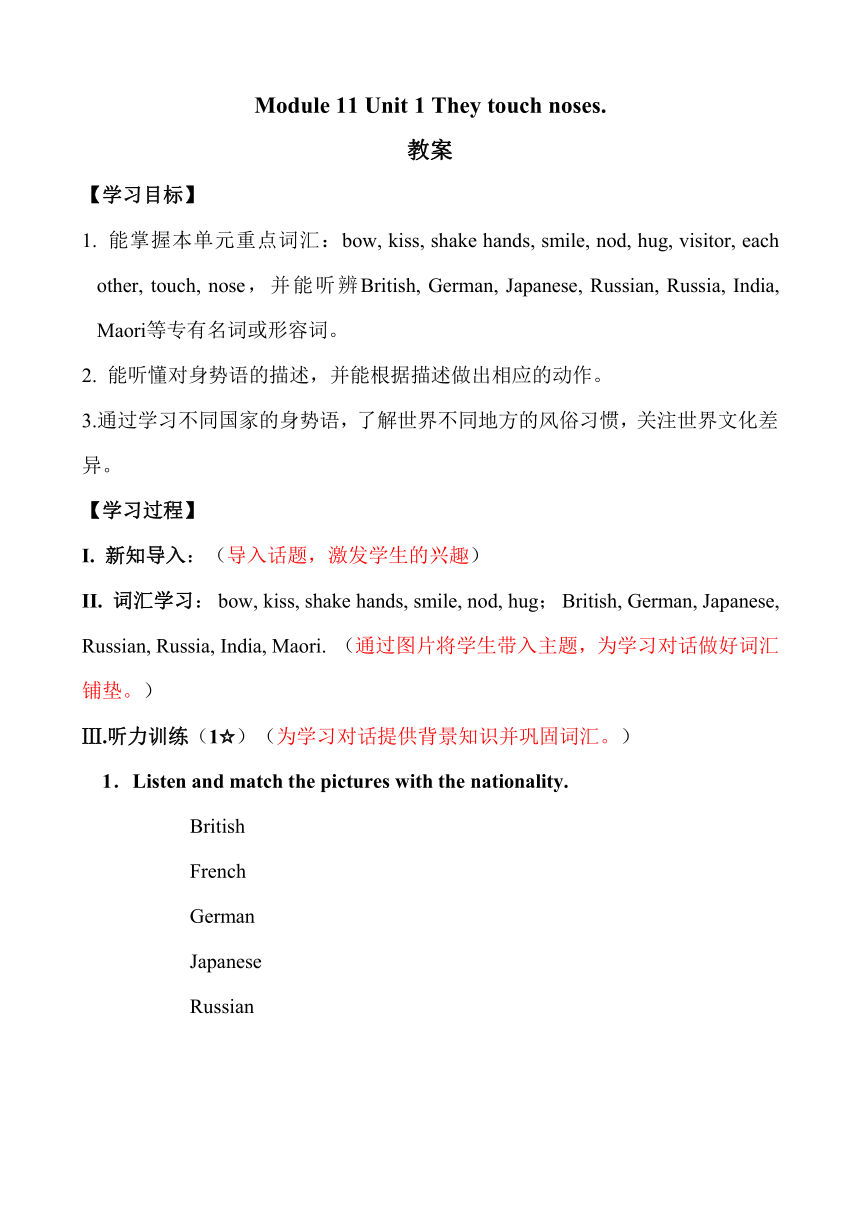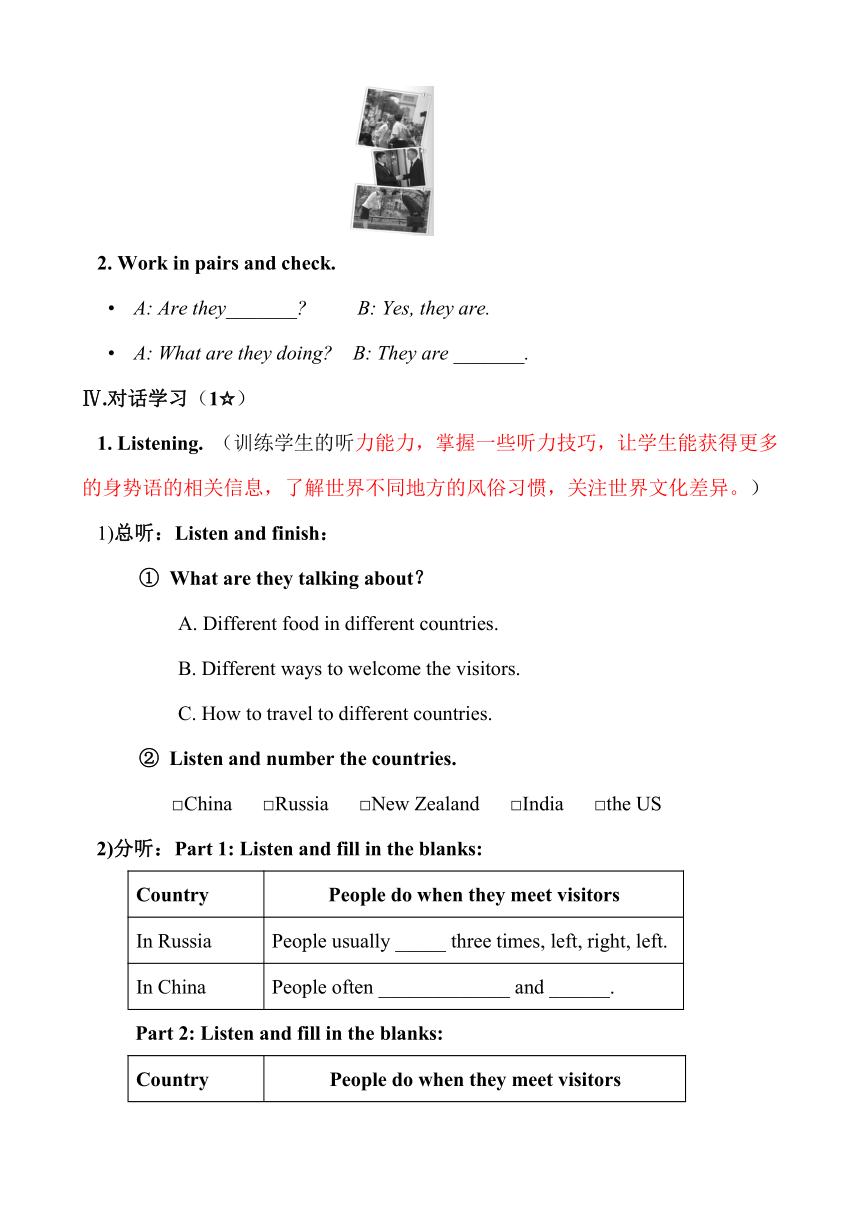Module 11 Body language Unit 1 They touch noses! 教案 (2)
文档属性
| 名称 | Module 11 Body language Unit 1 They touch noses! 教案 (2) |  | |
| 格式 | zip | ||
| 文件大小 | 299.2KB | ||
| 资源类型 | 教案 | ||
| 版本资源 | 外研版 | ||
| 科目 | 英语 | ||
| 更新时间 | 2016-10-10 11:07:15 | ||
图片预览


文档简介
Module
11
Unit
1
They
touch
noses.
教案
【学习目标】
1.
能掌握本单元重点词汇:bow,
kiss,
shake
hands,
smile,
nod,
hug,
visitor,
each
other,
touch,
nose,并能听辨British,
German,
Japanese,
Russian,
Russia,
India,
Maori等专有名词或形容词。
2.
能听懂对身势语的描述,并能根据描述做出相应的动作。
3.通过学习不同国家的身势语,了解世界不同地方的风俗习惯,关注世界文化差异。
【学习过程】
I.
新知导入:(导入话题,激发学生的兴趣)
II.
词汇学习:
bow,
kiss,
shake
hands,
smile,
nod,
hug;
British,
German,
Japanese,
Russian,
Russia,
India,
Maori.
(通过图片将学生带入主题,为学习对话做好词汇铺垫。)
Ⅲ.听力训练(1☆)(为学习对话提供背景知识并巩固词汇。)
1.Listen
and
match
the
pictures
with
the
nationality.
British
French
German
Japanese
Russian
2.
Work
in
pairs
and
check.
A:
Are
they_______
B:
Yes,
they
are.
A:
What
are
they
doing
B:
They
are
_______.
Ⅳ.对话学习(1☆)
1.
Listening.
(训练学生的听力能力,掌握一些听力技巧,让学生能获得更多的身势语的相关信息,了解世界不同地方的风俗习惯,关注世界文化差异。)
1)总听:Listen
and
finish:
①
What
are
they
talking
about?
A.
Different
food
in
different
countries.
B.
Different
ways
to
welcome
the
visitors.
C.
How
to
travel
to
different
countries.
②
Listen
and
number
the
countries.
□China
□Russia
□New
Zealand
□India
□the
US
2)分听:Part
1:
Listen
and
fill
in
the
blanks:
Country
People
do
when
they
meet
visitors
In
Russia
People
usually
_____
three
times,
left,
right,
left.
In
China
People
often
_____________
and
______.
Part
2:
Listen
and
fill
in
the
blanks:
Country
People
do
when
they
meet
visitors
In
the
US
People
shake
hands,
and
some
kiss
or
_____
each
other.
In
India
People
put
their
hands
together
and
_____their
heads.
In
New
Zealand
Maori
people
_____________.
2.Read
the
dialogue
quickly
and
silently,translate
the
phrases
and
find
out
the
difficulties
and
ask
others
for
help
.
要求:(1)先自主学习,独立完成。(2)在组长领导下讨论、组内订正答案。
1)亲吻三次
2)握手
3)点头
4)互相拥抱
5)双手合拢
6)碰鼻子
3.
Language
points:
1)
shake
hands
“握手”
;
shake
hands
with
sb.
“与某人握手”
①
She
is
shaking
hands
______
the
visitors.
A.
To
B.
in
C.
with
D.
at
②
我爸爸遇见朋友时,经常握手问好。
My
father
often_________________
his
friends
when
they
meet.
2)
hug
each
other
“互相拥抱”;
each
other
表示“彼此,互相”,
通常放在动词后。
①
As
friends,
we
should
______(互相帮助)
.
A.
help
each
B.
help
each
other
C.
each
other
help
②
他们因为成功而互相拥抱。They
______________
for
the
success.
4.
课文巩固:
1)大声跟读,注意语音语调,正确模仿。
2)角色朗读并展示(1☆)
5.
复述课文:(6人小组,一人1句)(2☆)
A
People
do
different
things
in
different
countries.
B
In
Russia
People
usually
_____
three
times,
left,
right,
left.
C
In
China
People
often
____________
and
______.
D
In
the
US
People
shake
hands,
and
some
kiss
or
_____
each
other.
E
In
India
People
put
their
hands
together
and
_____their
heads.
F
In
New
Zealand
Maori
people
_____________.
Ⅴ、学以致用:
(3☆)(提供语境,让学生尝试用英文和不同的身势语表达问候。)
Some
visitors
from
different
countries
will
come
to
our
school
tomorrow.
What
do
you
want
to
do
and
say
when
you
meet
them
(6人小组合作,边说边用身势语表示问候)
For
example:
A:
Good
morning!
Welcome
to
our
school.
...
B:
Thank
you!
I’m
from
Russia.
Nice
to
meet
you!
(
Do:
“kiss
three
times…”
)
C、D、E、F
are
from
different
countries….
……..
Ⅵ.
Summary:
Homework:
1.
Level
A:
Use
the
body
language
we
learnt
to
greet
visitors.
2.
Level
B:
Surf
the
Internet
to
find
more
body
language
from
other
countries.
.
11
Unit
1
They
touch
noses.
教案
【学习目标】
1.
能掌握本单元重点词汇:bow,
kiss,
shake
hands,
smile,
nod,
hug,
visitor,
each
other,
touch,
nose,并能听辨British,
German,
Japanese,
Russian,
Russia,
India,
Maori等专有名词或形容词。
2.
能听懂对身势语的描述,并能根据描述做出相应的动作。
3.通过学习不同国家的身势语,了解世界不同地方的风俗习惯,关注世界文化差异。
【学习过程】
I.
新知导入:(导入话题,激发学生的兴趣)
II.
词汇学习:
bow,
kiss,
shake
hands,
smile,
nod,
hug;
British,
German,
Japanese,
Russian,
Russia,
India,
Maori.
(通过图片将学生带入主题,为学习对话做好词汇铺垫。)
Ⅲ.听力训练(1☆)(为学习对话提供背景知识并巩固词汇。)
1.Listen
and
match
the
pictures
with
the
nationality.
British
French
German
Japanese
Russian
2.
Work
in
pairs
and
check.
A:
Are
they_______
B:
Yes,
they
are.
A:
What
are
they
doing
B:
They
are
_______.
Ⅳ.对话学习(1☆)
1.
Listening.
(训练学生的听力能力,掌握一些听力技巧,让学生能获得更多的身势语的相关信息,了解世界不同地方的风俗习惯,关注世界文化差异。)
1)总听:Listen
and
finish:
①
What
are
they
talking
about?
A.
Different
food
in
different
countries.
B.
Different
ways
to
welcome
the
visitors.
C.
How
to
travel
to
different
countries.
②
Listen
and
number
the
countries.
□China
□Russia
□New
Zealand
□India
□the
US
2)分听:Part
1:
Listen
and
fill
in
the
blanks:
Country
People
do
when
they
meet
visitors
In
Russia
People
usually
_____
three
times,
left,
right,
left.
In
China
People
often
_____________
and
______.
Part
2:
Listen
and
fill
in
the
blanks:
Country
People
do
when
they
meet
visitors
In
the
US
People
shake
hands,
and
some
kiss
or
_____
each
other.
In
India
People
put
their
hands
together
and
_____their
heads.
In
New
Zealand
Maori
people
_____________.
2.Read
the
dialogue
quickly
and
silently,translate
the
phrases
and
find
out
the
difficulties
and
ask
others
for
help
.
要求:(1)先自主学习,独立完成。(2)在组长领导下讨论、组内订正答案。
1)亲吻三次
2)握手
3)点头
4)互相拥抱
5)双手合拢
6)碰鼻子
3.
Language
points:
1)
shake
hands
“握手”
;
shake
hands
with
sb.
“与某人握手”
①
She
is
shaking
hands
______
the
visitors.
A.
To
B.
in
C.
with
D.
at
②
我爸爸遇见朋友时,经常握手问好。
My
father
often_________________
his
friends
when
they
meet.
2)
hug
each
other
“互相拥抱”;
each
other
表示“彼此,互相”,
通常放在动词后。
①
As
friends,
we
should
______(互相帮助)
.
A.
help
each
B.
help
each
other
C.
each
other
help
②
他们因为成功而互相拥抱。They
______________
for
the
success.
4.
课文巩固:
1)大声跟读,注意语音语调,正确模仿。
2)角色朗读并展示(1☆)
5.
复述课文:(6人小组,一人1句)(2☆)
A
People
do
different
things
in
different
countries.
B
In
Russia
People
usually
_____
three
times,
left,
right,
left.
C
In
China
People
often
____________
and
______.
D
In
the
US
People
shake
hands,
and
some
kiss
or
_____
each
other.
E
In
India
People
put
their
hands
together
and
_____their
heads.
F
In
New
Zealand
Maori
people
_____________.
Ⅴ、学以致用:
(3☆)(提供语境,让学生尝试用英文和不同的身势语表达问候。)
Some
visitors
from
different
countries
will
come
to
our
school
tomorrow.
What
do
you
want
to
do
and
say
when
you
meet
them
(6人小组合作,边说边用身势语表示问候)
For
example:
A:
Good
morning!
Welcome
to
our
school.
...
B:
Thank
you!
I’m
from
Russia.
Nice
to
meet
you!
(
Do:
“kiss
three
times…”
)
C、D、E、F
are
from
different
countries….
……..
Ⅵ.
Summary:
Homework:
1.
Level
A:
Use
the
body
language
we
learnt
to
greet
visitors.
2.
Level
B:
Surf
the
Internet
to
find
more
body
language
from
other
countries.
.
同课章节目录
- Module 1 Lost and found
- Unit 1 Whose bag is this?
- Unit 2 Are they yours?
- Unit 3 Language in use
- Module 2 What can you do ?
- Unit 1 I can play the piano
- Unit 2 I can run really fast
- Unit 3 Language in use
- Module 3 Making plans
- Unit 1 What are you going to do at the weekends?
- Unit 2 We're going to cheer the players.
- Unit 3 Language in use
- Module 4 Life in the future
- Unit 1 Everyone will study at home
- Unit 2 Every family will have a small plane.
- Unit 3 Language in use
- Module 5 Shopping
- Unit 1 What can I do for you?
- Unit 2 You can buy everything on the Internet
- Unit 3 Language in use
- Module 6 Around town
- Unit 1 Could you tell me how to get to the Nationa
- Unit 2 The London Eye is on your right.
- Unit 3 Language in use
- Revision module A
- Module 7 My past life
- Unit 1 I was born in a small village.
- Unit 2 I was born in Quincy.
- Unit 3 Language in use
- Module 8 Story time
- Unit 1 Once upon a time….
- Unit 2 Goldilocks hurried out of the house.
- Unit 3 Language in use
- Module 9 Life history
- Unit 1 He left school and began work at the age of
- Unit 2 He decided to be an actor.
- Unit 3 Language in use
- Module 10 A holiday journey
- Unit 1 What did you do?
- Unit 2 This morning we took a walk.
- Unit 3 Language in use
- Module 11 Body language
- Unit 1 They touch noses!
- Unit 2 Here are some ways to welcome them.
- Unit 3 Language in use
- Module 12 Western music
- Unit 1 It's so beautiful!
- Unit 2 Vienna is the centre of European classical
- Unit 3 Language in use
- Revision module B
